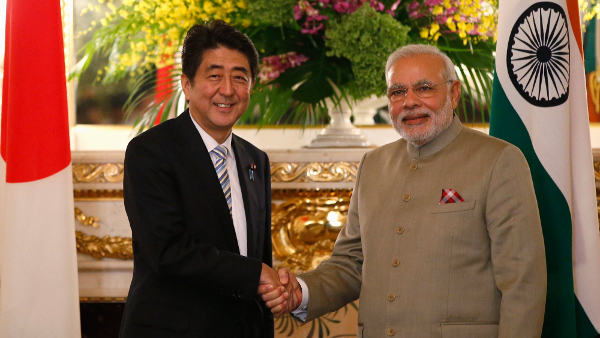TOKYO — India and Japan are set to become “quasi-allies” as they bolster security ties in the face of China’s rising military capabilities.
The two countries are planning their first foreign and defense ministerial meeting, dubbed 2+2, in India for late November, hoping to pave the way for an Indian summit next month between Japanese Prime Minister Shinzo Abe and his Indian counterpart Narendra Modi.
On the agenda will be sorting out the terms of an acquisition and cross-servicing agreement, or ACSA, to be used by their armed forces. If agreed, India will become the sixth nation with which Japan has inked an ACSA, following the U.S., U.K, France, Canada and Australia.
Japan has already signed agreements concerning the protection of classified military information and transfer of defense equipment and technology with India.
The new move will extend existing Japanese policy — in coordination with the U.S. — of checking China’s military expansion, specifically calling for a “free and open Indo-Pacific,” as well as maintaining maritime order based on the rule of law.
This regional vision did not arise by chance. Rather, it emerged to counter China’s ambitious Belt and Road Initiative, which is drawing countries into Beijing’s sphere of influence with a promise of economic support. Among those countries is Pakistan, which has a long-standing border dispute with India. Hence, it is in India’s interest to beef up bonds with Japan on the military front.
Improving relations has also carried over into the economic front, where Japan has been laboring to seal the 16-country Regional Comprehensive Economic Partnership. Japan hopes that India’s inclusion in the bloc will help dilute the economic clout of China, another member. But with India declining to sign the agreement earlier this month, Japanese officials will have to refocus policy, at least until India decides to join.
Leaders from Japan and India have been meeting each on a fairly regular basis, so a framework for continued cooperation is in place. The two countries upgraded relations when Modi and Abe met in 2014, rebranding their bilateral ties as a “Special Strategic and Global Partnership.” Since then, Japan has been pitching in, building urban infrastructure projects and a high-speed rail network.
And before ACSA, basic military cooperation was already underway, with Japan’s Ground Self-Defense Force and the Indian Army conducting joint anti-terrorism drills through Nov. 5 in India. Moreover, in a telling 2019 defense white paper, Japan replaced South Korea with India as its third-most important partner in security cooperation, behind Australia and the U.S.
India and Japan can do more to check China’s advances in the Indo-Pacific region through the revived U.S.-Japan-Australia-India strategic alliance, or Quad. Although the four have not held joint military exercises under Quad, their respective foreign ministers met for the first time on the sidelines of a U.N. General Assembly gathering in late September, a sign that the alliance may be increasing the level of cooperation.
But India has traditionally adhered to a policy of nonalignment, walking a fine line between the U.S. and China. If Quad military drills do take place, Japan will likely need to play the role of intermediary between India and the U.S., coaxing the former into a more definitive stance.
Source: NIKKIE
Image Courtesy: PIB
You may also like
-
IAF Aircraft Set Course For Exercise Eastern Bridge VII At Oman
-
IAF Set To Host The Indian Defence Aviation Exposition-II At Jodhpur
-
Defence Secretary to co-chair 5th India-Philippines Joint Defence Cooperation Committee meeting in Manila
-
Simultaneous Launch Of ‘malpe And Mulki’, Fourth And Fifth Ships Of Asw Swc (Csl) Project
-
Aatmanirbharta in Defence: MoD signs Contract with HAL for 240 AL-31FP Aero Engines for Su-30MKI Aircraft
